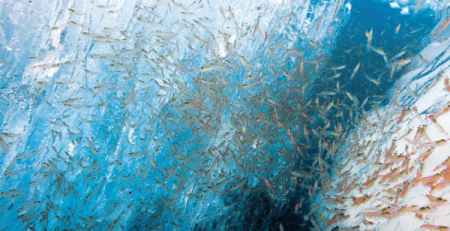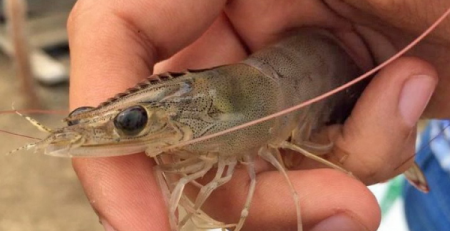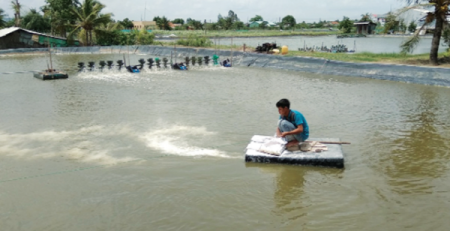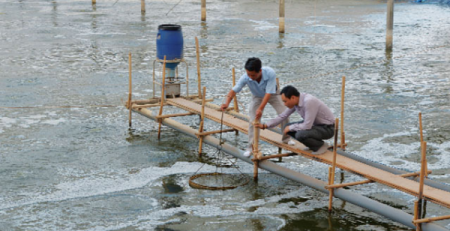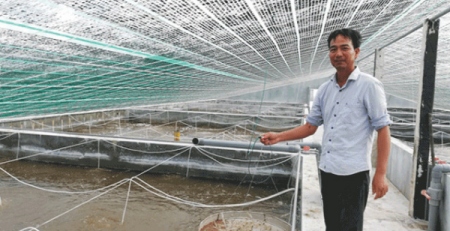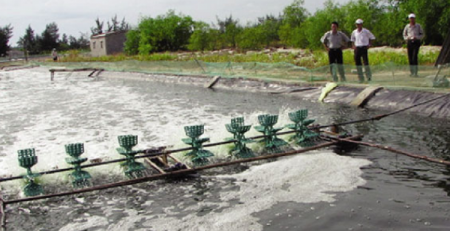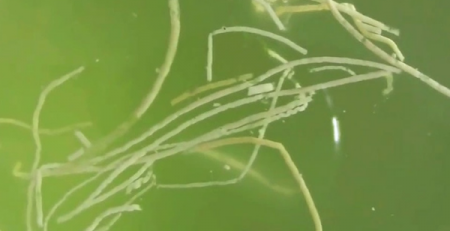H2S treatment in ponds
Nội dung bài viết [ẩn]
The article provides the reason for producing H2S toxic gas in ponds and measures to solve H2S problem in shrimp ponds when algae is dead and after heavy rains.

Reason
In ponds with clear water before stocking, algae grow on the pond bottom. Then, when phytoplankton bloom in pond water, it blocks light from reaching the algae at the bottom of the pond, causing the algae to collapse, resulting in the production of H2S.
Pond has sandy soil or porous soil.
The water level in the pond is deep and the oxygen level is insufficient, creating anaerobic conditions that lead to H2S production.
Ponds contain high levels of suspended organic matter. When organic matter settles to the bottom of the pond, it creates favorable conditions for the production of toxic gas H2S.
HDPE tarpaulin pool leaked. When organic matter seeps through these linings, into an oxygen-free area, H2S is created.
In ponds there is a high content of excess food and waste that has an algal blooms.
Acid sulfate ponds (acid sulfate) have low pH and high levels of organic matter to support H2S release.
Impact
H2S toxicity depends on 3 main parameters: pH, temperature and dissolved oxygen. H2S hinders shrimp’s oxygen transport process. Dissolved oxygen levels above 3 ppm help prevent H2S formation. When all 3 factors of pH, oxygen and low temperature make H2S even more dangerous.
In ponds, H2S causes severe oxygen deficiency, which has a very bad impact on shrimp growth and survival. The concentration of H2S in pond water ranges from 0.01 to 0.02 ppm, the shrimp will be poisoned and die mass. H2S causes more damage to fish farmers and shrimp farmers than other actors. For tiger prawns, they often live in the pond bottom; This is the reason that shrimp are stressed and weak, susceptible to Vibrio infection, or more seriously, the shrimp will die (syndrome of raising head).
Handling algae
Once there is an algae problem, the pH will drop immediately. The concentration of organic matter will increase dramatically, leading to sudden oxygen absorption. Toxic gases will be released and bacteria will thrive. It should be done as follows:
Cut food intake by 50-60%.
Use fine lime to maintain pH and float dead plankton. Then quickly remove them from the pond.
Enhance running aeration to concentrate waste in the middle of the pond.
Replace water by sucking mud in the center of the pond.
Use of H2S consuming bacteria.
Solution
Immediately cut food intake by 30-40% for at least 3 days until conditions return to normal.
Enhance aeration immediately (but be aware of mud disturbance during the installation of new aerators).
Replace the water to ensure it maintains clean water and use probiotics.
Use lime immediately to increase pH to more than 7.8.
Use of microorganisms that can consume H2S such as Paracoccus pantothrophus.
How to prevent H2S problem while heavy rain?
At 3 am, always ensure that the dissolved oxygen level in your shrimp pond is higher than 3 ppm (from 3 meters from the mud edge and 30 cm from the pond surface).
Feed the shrimp according to their needs, limiting excess feeding.
Monitoring and management of organic matter in ponds using bottom siphoning.
Avoid cultivating in porous or sandy soil or in acidic soil.
Keeping the pH in the range of 7.8 to 8.3 throughout the crop. Need to ensure the daily pH fluctuation must be <0.4.
Source: Vietnam Fisheries Magazine


